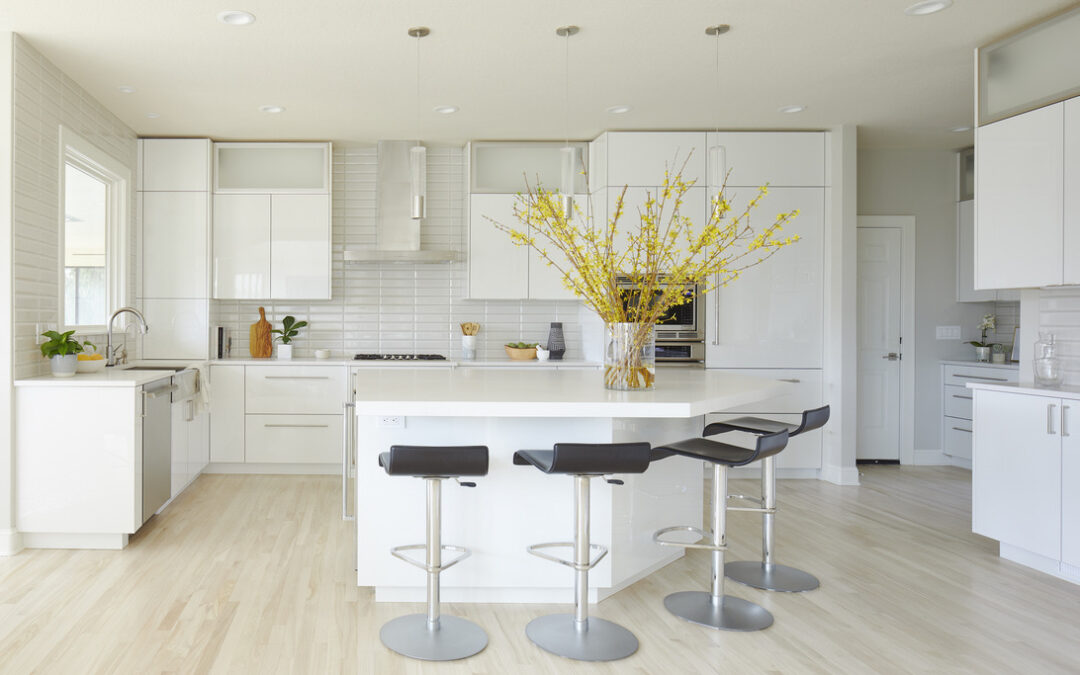Your hardwood floors are a valuable investment that requires proper care to maintain their appearance. As the temperature fluctuates from summer to winter, so do humidity levels. While high heat or low temps don’t impact hardwood floors, it’s important to note that humidity levels can harm them.
Understanding Humidity
Humidity is often referred to as “relative humidity” in weather reports. National Geographic defines relative humidity as the actual amount of water vapor present in the air compared to the maximum amount the air can hold at a specific temperature. For instance, if the relative humidity is 50 percent, the air can hold 50 percent more water vapor than it currently does.
How Humidity Affects Your Floors
During the colder months, low humidity can cause hardwood floors to shrink, resulting in gaps and cracks. The reduced moisture content causes the cells or pores of the hardwood to contract. All hardwood will experience slight separation during the winter months, especially in Iowa where cold winters and furnaces can reduce the moisture in your home significantly.
In contrast, high humidity levels in the summer can cause your hardwood floors to expand back to their normal state—and then some. The increased moisture content in the air is absorbed by the hardwood, leading to expansion. Fortunately, the presence of baseboards helps mitigate the impact of seasonal expansion and contraction by allowing a small gap around the edges of the flooring.
4 Ways High Humidity Affects Your Floors
If there is excessive moisture present or if your hardwood flooring has been poorly installed, high summer humidity can negatively affect the quality and appearance of your hardwood floors. Here are some common issues that can arise.
Buckling
When hardwood floorboards take in extreme moisture, they bloat beyond their normal size. This broadening causes floorboards to separate from the subfloor, resulting in buckling or bowing. The increased pressure can cause your boards to lift or create noticeable unevenness in the flooring.
Cupping
High humidity beneath the floor can bring moisture to the underside of your hardwood floorboards. As the boards soak up this moisture, the edges tend to swell and rise, while the center of the boards remains lower. This leads to a concave or cupped appearance across your floor.
Crowning
In contrast to cupping, crowning occurs when the center of the hardwood floorboards becomes higher than the edges. This happens as a result of long-term moisture imbalances, where the surface of your floor is exposed to high moisture while the underside remains relatively dry.
Cracking
Enlarged boards caused by extreme humidity levels can lead to boards pushing against each other, exerting pressure, and resulting in cracks. This compromises the structural integrity and visual appeal of your hardwood flooring.
How to Check For and Balance Humidity Levels
During the summer, there are several ways you can prevent humidity from affecting your hardwood floors. It is recommended to manage humidity levels for your hardwood floors within the range of 35 percent to 50 percent.
Monitoring the humidity level in a room is easy with the use of a hygrometer, a simple and affordable device that can be purchased for around $10. By clicking a button, you can instantly determine the humidity level and take appropriate measures if it exceeds the recommended range. If you find that your room is higher than 50 percent humidity, consider the following tactics to ensure the well-being of your hardwood floors.
Dehumidifier
Using a dehumidifier in a room can help regulate humidity levels. Portable dehumidifiers come in various sizes suitable for different room sizes, and they can also be installed on your HVAC system for year-round humidity control. These are often helpful in basements during the summer months.
Cleaning
Maintaining cleanliness is key to achieving balanced humidity levels on your hardwood floors. By making sure water doesn’t sit on your floors, you can minimize the accumulation of unnecessary humidity. It is crucial to use appropriate cleaning products that are specifically designed for the finish applied to your floor. Different finishes, such as sealed and unsealed, require different cleaning methods and products to uphold their condition.
Additionally, it’s important to take a closer look at the items within your home. Clutter can impede proper airflow and lead to moisture buildup. Be mindful of eliminating needless items and organizing your living space.
Moreover, while indoor plants add beauty to your home, an excessive number of plants can elevate humidity levels. Consider finding a balance and strategically placing plants to counter spikes in humidity.
Air Conditioner
Installing a central air conditioning system helps remove sticky, humid air from your home by collecting moisture in its coils and draining it outside. This expense enhances your comfort and safeguards your hardwood floor investment throughout the sweltering summer months in the Midwest.
Humidifiers
Humidifiers are critical during the winter months. When you turn your furnace on for the winter, you should also be turning on your humidifier. You can purchase a stand-alone humidifier that you fill daily, or preferably, have a humidifier installed on your furnace. This can help minimize (not prevent) separation between the boards during the winter months
Fans
Exhaust fans, ceiling fans, and standing fans play a role in providing proper airflow and diminishing humidity levels in your home. When you’re cooking in the kitchen or showering in the bathroom, it is beneficial to develop a habit of using exhaust fans. These fans effectively dissipate moisture and prevent it from lingering and contributing to elevated humidity levels within your house.
While ceiling and standing fans do not directly lower humidity, they limit humidity from settling in specific areas. By circulating the air in your home, fans ensure that humidity doesn’t become stagnant and create that uncomfortable, stuffy feeling associated with excess indoor moisture.
Clean Your Gutters
Regularly cleaning your gutters is essential for lessening moisture in your home. Clogged gutters can trap water and cause moisture-related damage. This can affect the overall humidity levels inside your house. Clean your gutters at least twice a year and consider installing gutter guards.
Protect Your Floors With Barnum Floors
At Barnum Floors, we are committed to helping you combat high humidity during the summer and safeguard the beauty of your hardwood floors. Contact us today to learn more and schedule a refinishing or brand-new installation.


Recent Comments